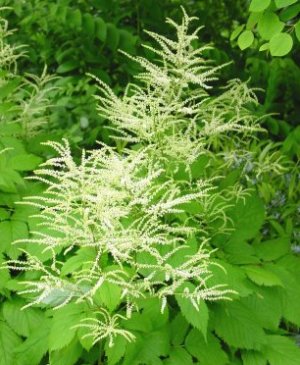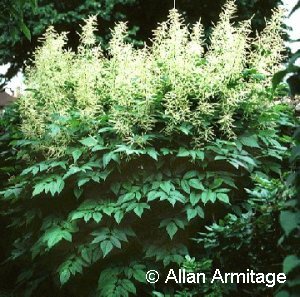
Aruncus dioicus
goat's beard, bride's feathers
A fantastic native with large, fine-textured feathery blooms in late Spring. Though closely related to Spiraea, goat's beard more closely resembles a giant Astilbe. When happy, Aruncus can be a formidable garden plant, reaching a spread of 6 feet or more. It is lovely when used at woods edge and it can provide a dense screen beneath a high canopy.
| SIZE | |
|---|---|
| Aruncus dioicus - 50 per flat | Availability |
Height4-6 Feet |
Spread6 Feet |
Spacing4-5 Feet |
Bloom ColorWhite |
USDA Hardiness Zone 5-9 |
goat's beard, bride's feathers Interesting Notes
Aruncus dioicus is found along moist streambeds and does best in dappled shade with sufficient moisture. The plant can grow 3-4’ tall with an almost 6 foot spread when happy. In areas above zone 7, Aruncus dioicus can take a fair amount of sun as long as it has consistent moisture. However, in the South, it prefers shade or else the heat will cause the plant to melt down mid-summer. Plant is dioecious with separate male and female plants – male plants are said to have fuller and more upright plumes of flowers while the female plants droop and sway as they bloom and extend the interest with seed.
Goatsbeard grows along moist woodlands and along bluffs throughout the Appalachia and the Missouri River region. It prefers humus-rich, well-drained soil.
Grown as a shrubby midlayer in our shade gardens, this plant is slow to establish but provides excellent groundcover and interest when in bloom.
Aruncus dioicus hosts a wide variety of pollinators but for staminate flowers, short tongued bees and beetles dominate, taking nectar and pollen, while on pistillate flowers, wasps, bees, beetles, and flies suck the nectar.
Aruncus dioicus Growing and Maintenance Tips
"The best site is one in partial shade with moisture-retentive soil. In areas with cool summers, Aruncus can be grown in full sun. Aruncus dioicus has a large spread. It should be initially placed 4'-5' between plants to allow for mature spread and to save the labor required to transplant a large Aruncus. To propagate, division is a suitable method but it is hard work and the species rarely needs to be divided. Seed propagation can be done with cold moist stratification."-Steven Still, Manual of Herbaceous Ornamenal Plants
Key Characteristics & Attributes





Additional Information
|
Soil Moisture Needs
|
Green Infrastructure
|
Wetland Indicator Status
|
Plug Type
|
||||||||||||
|
Attributes
|
Season of Interest (Flowering)
|
Propagation Type
|











